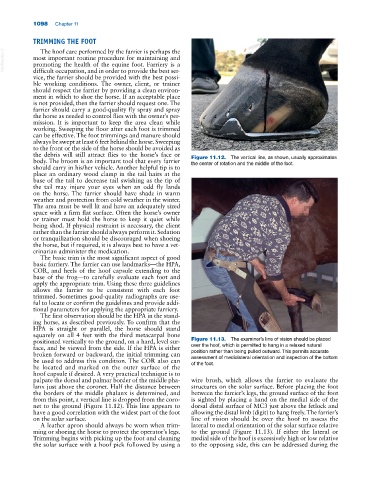Page 1132 - Adams and Stashak's Lameness in Horses, 7th Edition
P. 1132
1098 Chapter 11
TRIMMING THE FOOT
The hoof care performed by the farrier is perhaps the
VetBooks.ir most important routine procedure for maintaining and
promoting the health of the equine foot. Farriery is a
difficult occupation, and in order to provide the best ser
vice, the farrier should be provided with the best possi
ble working conditions. The owner, client, or trainer
should respect the farrier by providing a clean environ
ment in which to shoe the horse. If an acceptable place
is not provided, then the farrier should request one. The
farrier should carry a good‐quality fly spray and spray
the horse as needed to control flies with the owner’s per
mission. It is important to keep the area clean while
working. Sweeping the floor after each foot is trimmed
can be effective. The foot trimmings and manure should
always be swept at least 6 feet behind the horse. Sweeping
to the front or the side of the horse should be avoided as
the debris will still attract flies to the horse’s face or
body. The broom is an important tool that every farrier Figure 11.12. The vertical line, as shown, usually approximates
the center of rotation and the middle of the foot.
should carry in his/her vehicle. Another helpful tip is to
place an ordinary wood clamp in the tail hairs at the
base of the tail to decrease tail swishing as the tip of
the tail may injure your eyes when an odd fly lands
on the horse. The farrier should have shade in warm
weather and protection from cold weather in the winter.
The area must be well lit and have an adequately sized
space with a firm flat surface. Often the horse’s owner
or trainer must hold the horse to keep it quiet while
being shod. If physical restraint is necessary, the client
rather than the farrier should always perform it. Sedation
or tranquilization should be discouraged when shoeing
the horse, but if required, it is always best to have a vet
erinarian administer the medication.
The basic trim is the most significant aspect of good
basic farriery. The farrier can use landmarks—the HPA,
COR, and heels of the hoof capsule extending to the
base of the frog—to carefully evaluate each foot and
apply the appropriate trim. Using these three guidelines
allows the farrier to be consistent with each foot
trimmed. Sometimes good‐quality radiographs are use
ful to locate or confirm the guidelines and provide addi
tional parameters for applying the appropriate farriery.
The first observation should be the HPA in the stand
ing horse, as described previously. To confirm that the
HPA is straight or parallel, the horse should stand
squarely on all 4 feet with the third metacarpal bone
positioned vertically to the ground, on a hard, level sur Figure 11.13. The examiner’s line of vision should be placed
face, and be viewed from the side. If the HPA is either over the hoof, which is permitted to hang in a relaxed natural
broken forward or backward, the initial trimming can position rather than being pulled outward. This permits accurate
be used to address this condition. The COR also can assessment of mediolateral orientation and inspection of the bottom
be located and marked on the outer surface of the of the foot.
hoof capsule if desired. A very practical technique is to
palpate the dorsal and palmar border of the middle pha wire brush, which allows the farrier to evaluate the
lanx just above the coronet. Half the distance between structures on the solar surface. Before placing the foot
the borders of the middle phalanx is determined, and between the farrier’s legs, the ground surface of the foot
from this point, a vertical line is dropped from the coro is sighted by placing a hand on the medial side of the
net to the ground (Figure 11.12). This line appears to dorsal distal surface of MC3 just above the fetlock and
have a good correlation with the widest part of the foot allowing the distal limb (digit) to hang freely. The farrier’s
on the solar surface. line of vision should be over the hoof to assess the
A leather apron should always be worn when trim lateral to medial orientation of the solar surface relative
ming or shoeing the horse to protect the operator’s legs. to the ground (Figure 11.13). If either the lateral or
Trimming begins with picking up the foot and cleaning medial side of the hoof is excessively high or low relative
the solar surface with a hoof pick followed by using a to the opposing side, this can be addressed during the

